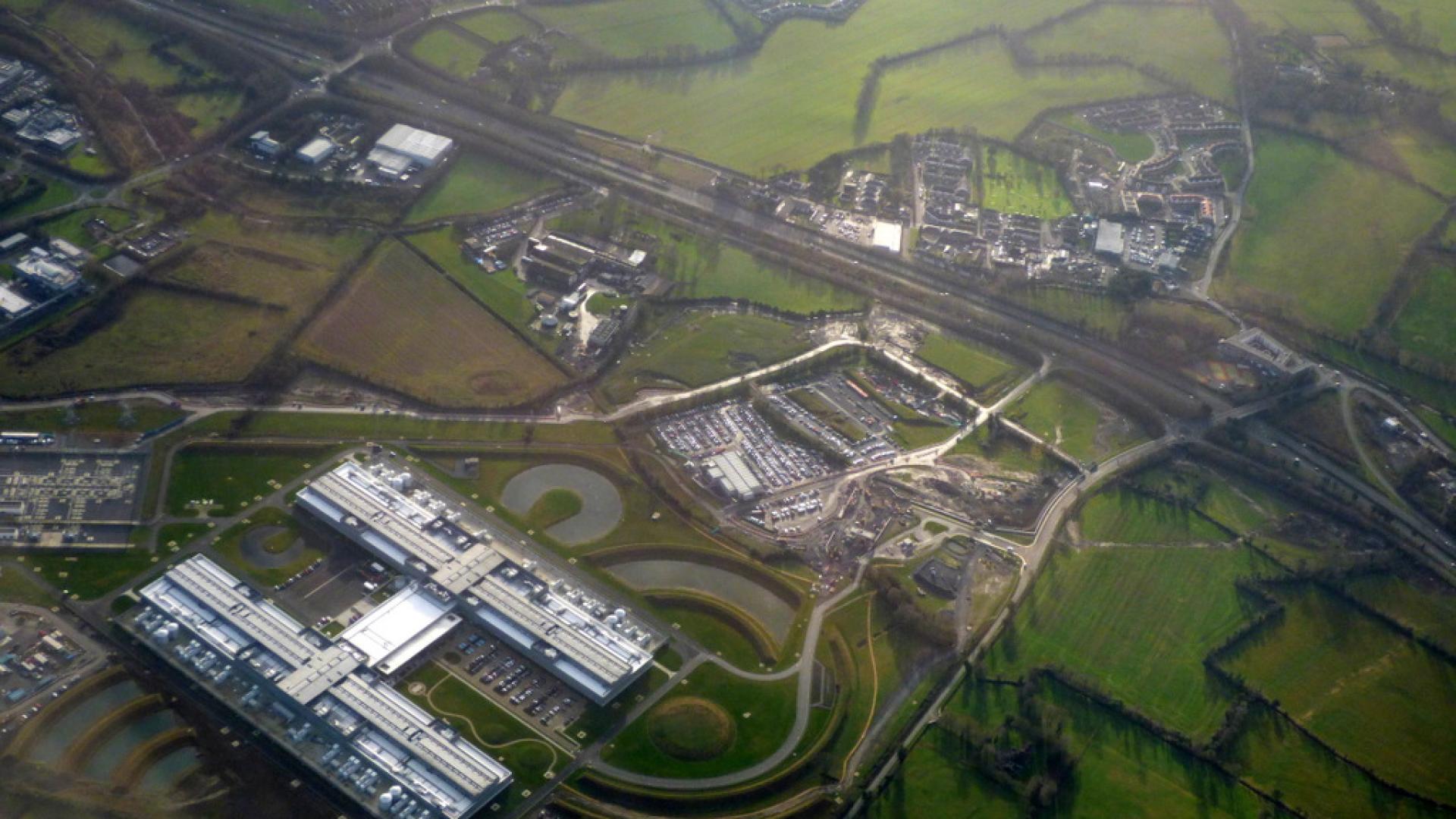Mary Stevens26 Oct 2025
Data centres are an essential part of the modern digital economy and society. We all use them for services we take for granted, from online banking to streaming entertainment. But the digital economy does not exist in a ‘cloud’ and it cannot be separated from the living physical world. This technology relies on energy for electricity, water for cooling and a huge quantity of materials and minerals for buildings and components.
The recent boom in Artificial Intelligence (AI) applications has resulted in big increases in demand for computing power, with billions of dollars pledged by global corporations for further growth, including here in the UK. As this sector grows, it’s essential that this growth shouldn't cause harm to communities, both here and in the global south where many of the raw materials come from.
Friends of the Earth is not opposed to the use of Artificial Intelligence. These technologies have huge potential to help address big societal challenges, including climate breakdown. But governments and business must act now to ensure that this technology is focused on delivering societal benefits, such as environmental restoration and human wellbeing, not just increasing the wealth of a small number of global tech companies and their billionaire owners.
Why digital infrastructure is an environmental justice issue
Our digital lives depend on a huge amount of physical infrastructure, from cables to pylons, to multiple computer servers joined together in warehouses (data centres). But as demand for services grows so the negative impacts on people and nature increase. In many parts of the world we are already seeing direct conflict between communities and digital service providers over clean air, green spaces and access to water and power. For example, in the United States, data centres are often being located in the majority Black neighbourhoods in the south, alongside new fossil fuel power plants causing significant health impacts. In Uruguay, Friends of the Earth has been campaigning against a Google data centre that originally planned to use as much drinking water as 55,000 households; meanwhile, because of drought, water quality in the capital became so poor the government advised pregnant women and people with serious health conditions not to drink tap water.
Globally, data centres are also driving up emissions of greenhouse gases at a time when we urgently need large-scale cuts. The International Energy Agency expects emissions from data centres to double in the next five years, due to a combination of reliance on existing dirty grids and the need for continuous power, leading to the installation of new gas turbines even on sites primarily powered by renewables. The demand for minerals as well as the growing mountain of e-waste, which is mostly exported to poorer countries for processing, is increasing the risk of armed conflict in places like Congo and exposing people on low incomes to life-shortening toxic chemicals.
In 2022, the UK’s Greater London Authority told housing developers in three west London boroughs that new housing projects could be blocked until 2035, because despite the housing crisis, all the electricity capacity had been allocated to data centres. Moreover, following agreements made through the Technology Prosperity Deal between the UK and the USA, the USA may seek to require the UK government to prioritise the demands of US tech companies in the event of power shortages - or face legal action. The current heavy water and power demands of data centres could in theory mean putting up bills (as is already happening in Ireland) or restricting supply to ordinary people, for purposes that include providing continuous service for social media sites like TikTok and YouTube.
What’s the situation in the UK?
Data centre growth is significant internationally and Friends of the Earth will work in solidarity with our international network on these issues. However, this article addresses the situation in the UK.
Is the government really in control of AI development?
The UK government is strongly committed to positioning the UK as a digital leader and puts a lot of emphasis on AI as a driver of growth - committing £2bn to AI growth through the 2025 Spending Review. The government’s AI Opportunities Action Plan sets out a plan to make the UK an ‘AI superpower’ and lays out how it will create AI Growth Zones, areas with ‘enhanced access to power and support for planning approvals.’ The first AI Growth Zone has been announced for Culham in Oxfordshire, with more announcements expected towards the end of 2025.The recent US Technology Prosperity Deal was celebrated by Business and Trade Secretary Peter Kyle for attracting ‘record-breaking investments’, worth a total of £150 bn – including £31bn from US corporations for technology infrastructure. Yet alongside the cash, the agreement also indicated a willingness to allow future policy on AI frameworks, data regulation and associated standards to be set by the US, putting American companies at the helm in delivering critical future infrastructure. This doesn’t only undermine the UK’s identity as a global leader, but also government power in determining future rules around data.
Ballooning energy demand
In June 2025 the National Energy System Operator told the government that it expected data centre electricity demand to triple by 2030 to around 7% of domestic demand, although its own Clean Power implementation analysis projects a more than five-fold increase. Globally, by 2035, data centres are projected to consume more than three times current UK annual consumption. The Chief Executive of the National Grid stated in 2024 that he expected power use by UK data centres to increase six-fold in the next ten years. Electricity consumption was already projected to rise significantly over the next decade as people switch to heat pumps and electric vehicles.
In Wales, the National Infrastructure Commission concluded that to hit the government’s target of 100% renewable electricity by 2035, generation must nearly quadruple in a decade. It also warned that this target is increasingly out of reach — without even considering the impacts of planned data centres, which could account for as much as 20% of Wales’s current demand.
Even if this demand can be met, there is no question that the growth in AI data centres is not only significantly increasing the scale of the clean energy generation challenge. It’s also increasing the harmful impacts on the communities and ecosystems where the minerals, on which the infrastructure for both data centres and renewable energy rely, are produced.
Concerns about water consumption
According to the government, water and power considerations are being actively taken into consideration in the development of AI growth zones, and the zones are ‘designed to attract investment in areas where existing energy and water infrastructure is already in place.’ In reality, a number of different bodies have expressed concerns about how realistic this approach is. The Government Digital Sustainability Alliance (a cross-sector group convened by the government to drive progress on the sustainability of the UK government’s digital operations) recently argued:
The UK's ambition to be a global leader in AI and a top destination for technology businesses currently creates a direct tension with its Net Zero commitments and existing water scarcity challenges. […] . Unmanaged AI growth risks undermining broader sustainability goals.
Water companies and the Environment Agency have also been warning the government about the pressures on water supplies. The 2025 National Framework for Water Resources report points out that the lack of accurate information to assess the impacts of water consumption is creating a serious barrier to strategic planning.
For example, Thames Water, the supplier most affected by data centre growth, has been unable to provide accurate figures for either the volumes of water consumed or the exact number of data centres it currently supplies. In its 2025-30 business plan, the utility simply states that a ‘large facility’ might use between 4 and 19 million litres of water per day, without providing evidence or highlighting the need to factor in the location of the data centre. For context, this is the equivalent of between 28,000 and 132,000 households.
Research by TechUK, in collaboration with the UK government, concluded, on the basis of a voluntary survey of 73 sites in England that ‘commercial data centres are not intensive water users.’ 51% of surveyed sites used waterless cooling systems and 64% used less than 10 million litres per year, although 4% used more than 10 times this. Worryingly, 5% of surveyed operators using water in their systems did not measure water use at all. However, this research is limited to a minority of sites as there are thought to be over 500 operational facilities in England. Total water usage by the sector in the UK is unknown as data centres do not routinely share data.
Communities in the dark
We are also concerned that gaps in the information supplied by data centre providers may be making it difficult for communities to hold companies to account, and for local planning authorities to make informed decisions. Organisations such as the National Engineering Policy Centre (NEPC) and the Royal Academy of Engineering have strongly urged the UK government to require tech companies to submit mandatory reports on a range of measures, including energy sources, water consumption and their approach to reuse and recycling.
It may soon become even harder for local communities to influence decisions. The government has already amended the National Planning Policy Framework (NPPF) to expressly support data centre development and site allocation. It’s planning to consult on allowing applicants for larger data centres to opt into the Nationally Significant Infrastructure Projects regime (NSIPs) - taking responsibility for consenting out of the hands of local authorities and handing it over to central government. In the last year the Secretary of State has already overruled the decision of Local Authorities on large data centres three times.
It’s worth noting that data centre applications are also often hard to identify in the early stages of the planning process, as they are classified as ‘B8 Storage and Distribution’ or ‘sui generis’ (other). This means they often don ‘t come to the attention of local communities, or even local elected representatives, until it’s too late to raise objections. It’s also concerning that the local planning authority (LPA) does not have a duty to consult with water companies, nor do water companies need to be consulted, so timely advice about potential water shortages may not be forthcoming, unless the LPA directly seeks it.
What we want
Earlier this year we signed a joint statement setting out how we think the environmental impact of AI and data centres should be limited. The statement calls for ‘policymakers, industry leaders and all stakeholders to acknowledge the true environmental costs of AI, to phase out fossil fuels throughout the technology supply chain, to reject false solutions [such as carbon offsetting] and to dedicate all necessary means to bring AI systems in line with planetary boundaries.’
In the UK context, we think there are some specific changes that government and business need to make.
Transparency
- The government must require data centre operators to submit mandatory annual reports covering:
- Energy mix (the balance of renewable and fossil-fuel power, including the use of back-up gas or diesel generators);
- Energy efficiency (known as Power Usage Effectiveness, or PUE);
- Water consumption and withdrawal;
- Reuse of server equipment and e-waste recycling.
- Basic annual reporting (e.g. on energy, water use and efficiency) should apply to all data centres with a power demand above 100-kW, with more detailed information required from larger sites. Aggregating this information in an accessible format would also make it easier to understand the cumulative impact of data centres and support the regulators to take an informed view about grid and water capacity.
- Data centres must be required to report on heat loss and produce plans for how they will capture and use excess heat in the future, as is already the case in Germany. The UK government should collaborate with international partners to enable consistent reporting across borders.
- Trade and investment agreements covering the provision of data centres must be subject to full parliamentary scrutiny and guarantee the retention of regulatory control by the UK.
Energy
- Data centres must be required to source 100% renewable electricity, with strict additionality criteria to ensure that only newly added renewable capacity counts, as an essential condition for the genuine phase-out of fossil fuels. Biofuels and carbon capture and storage should not be considered ‘renewable’ or ‘clean’.
- The Government should work with the Climate Change Committee and the National Energy System Operator to ensure that its growth plans for data centres are in line with carbon budgets. Assumptions for growth in electricity demand linked to data centres should be explicitly factored into the climate plan that will be produced to meet the Seventh Carbon Budget (for the period 2037-2042) by June 2026.The Climate Change Committee and civil society should be represented on the AI Energy Council. The government also urgently needs to convene the AI Sustainability Working Group (a sub-group of the Energy Council, which has not yet met) and publish its deliberations.
Water, nature and resources
- Water companies must be made statutory consultees for all data centre applications with a power demand above a certain threshold (we suggest a maximum of 100-kW) to ensure their concerns are factored into decision-making and comments on the formal planning register.
- Water companies, the government and the tech sector must work together to plan adequately for the water needs of data centres, including the needs associated with energy generation, without compromising the needs of domestic customers or harming the natural environment. All data centre operators must set ambitious water reduction targets for both new and existing data centres.
- We need a new Business, Human Rights and Environment Act to hold UK companies and the public sector legally accountable if they fail to prevent human rights abuses or environmental harm in the UK or overseas – and it’s essential that there are no loopholes for the tech sector, given the importance of rare metals and minerals in the tech supply chain.
Waste
- The government must develop circular strategies for tech and infrastructure sectors and require developers to submit Circular Economy Statements and whole-life cycle carbon assessment for data centre projects (local planning policy in Greater London already requires this).
- The government should allocate AI innovation funding to promoting smaller scale, more efficient AI solutions, that use smaller models and have a smaller footprint.
Planning and democracy
- As a minimum, water companies need to be made statutory consultees for data centres, to be better able to gauge the cumulative demands on water supplies, suggest alternative non-potable water source options and raise other relevant concerns.
- Environmental Impact Assessments should be required for all data centre applications (data centres added to Schedule 1 of the EIA regulations 2017 due to likely ‘significant effects’ on water, climate and air quality).
- Plan-making (local and strategic) should play a key role in ensuring data centres are only allocated in the most suitable areas, and planning applications must align with these allocations. National government (in identifying ‘AI Growth Zones’) and local government (as local plan makers) must consider the cumulative impact of making allocations on a host area, linked to a range of environmental indicators (water, emissions, biodiversity etc). Strategic site selection must demonstrate how cumulative effect has been considered, in contrast to the current ad-hoc case-by-case application approach.
- The government should introduce a new stand-alone use class for data centres in the planning system (rather than classifying them as ‘storage and distribution’ or ‘mixed use’). This would allow more effective consideration and scrutiny of their specific requirements and enable a cumulative picture of applications to emerge.
- Local communities must have the time and the information necessary to respond meaningfully to local plan consultations linked to the allocation of sites for new data centres (and relevant associated policies).
Conclusion
Managed well, data centres have an important role to play in national resilience and in the shift to a fossil-free, healthier future. But at the moment all the power is in the hands of a very small number of ‘big tech’ companies, and any profits are mostly being channelled off-shore while communities are landed with the long-term costs.
Given the widespread concerns detailed in this article, Friends of the Earth believes that this is the time for a wider national conversation, including measures such as citizen assemblies, to engage people in the UK with what is really happening in data centre development and the purposes they serve.
The demands set out in this paper are intended to start to shift the balance away from big tech, restore more power to communities and ultimately enable a much more informed conversation about the digital infrastructure we really need, what the planet can support and the price we want to pay for it.
Further reading
Friends of the Earth report: Harnessing AI for environmental justice | Policy and insight
Friends of the Earth blog: The hidden values shaping AI development - and what to do about them | Experiments
Green Web Foundation: Report: Thinking about using AI? - Green Web Foundation
Green Screen Coalition: Within Bounds: Limiting AI's environmental impact
Green Screen Coalition resource library: Library : Green Screen Coalition
The AI Threats to Climate Change: Climate Action Against Disinformation | The AI Threats to Climate Change
MySociety AI framework: mySociety AI Framework
The Environmental Impacts of AI -- Primer
Global Action Plan : What's the deal with data centres?
Take action! UK: Don't Sell Out to Big Tech to Appease Trump | Global Justice Now
Biofuelwatch webinar: https://www.youtube.com/watch?v=z0B0CiH_4Ek
Data centres: planning policy, sustainability, and resilience - House of Commons Library
How data center expansion risks derailing climate goals and what to do about it – Open Future
Climate Movement AI Hub: Climate Movement AI Hub (thanks to Ajaya Haikerwal)



